
Alexander Heinle
Alex is a marketer at Zavvy. On this blog, he mainly shares insights gained from discussions with selected experts and from helping our customers set up and improve their onboarding or learning programs.

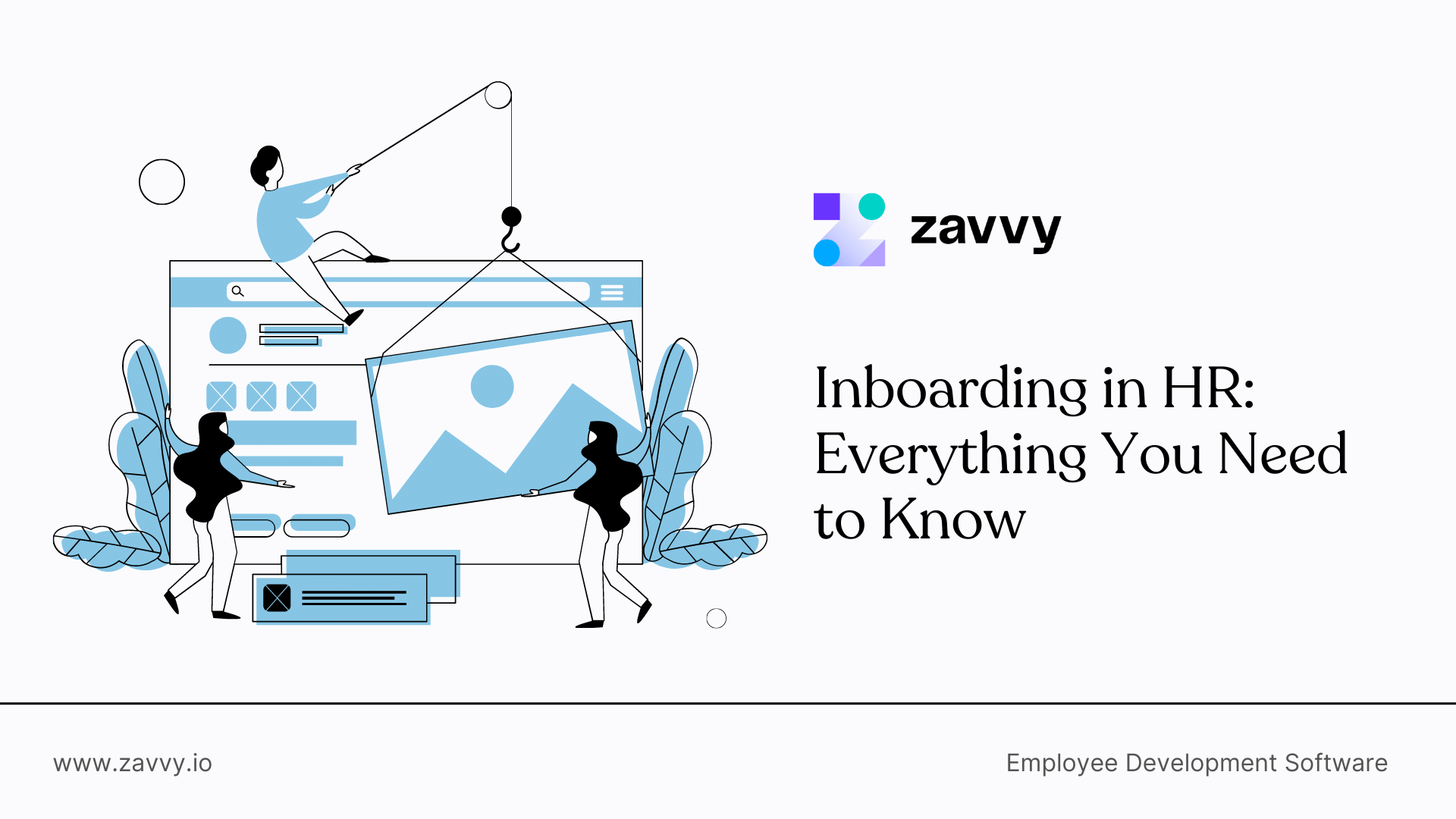
Companies everywhere have recognized the need for a good employee onboarding process. But they have overlooked a vital step: retaining these workers.
With 50% of employees leaving after the first two years of employment, there's a need to motivate workers to remain with the organization. The only catch? Hiring new talent and retaining them cannot be achieved with the initial onboarding alone.
You need to implement a second "onboarding process," known as inboarding. Let's see what it means and why it is an integral part of any HR process.
Together with our curators, we have created a library of actionable digital marketing resources. Personalized to your team's needs.
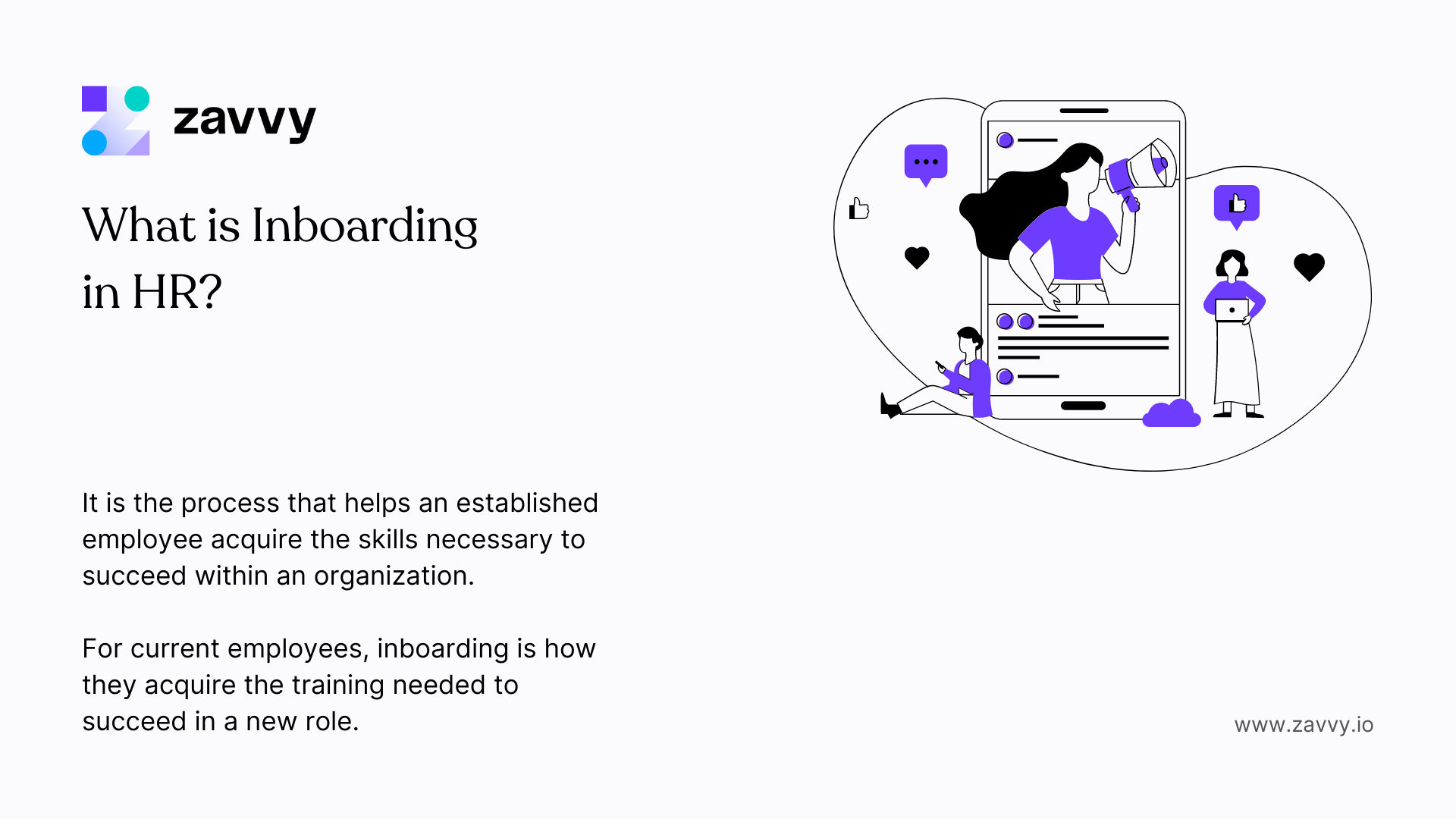
Inboarding is derived from 'inboard,' which means 'within a ship.'
In HR, this term means the process that helps an established employee acquire the skills necessary to succeed within an organization. For current employees who want to get promoted or move to a different location, inboarding is how they acquire the training needed to succeed in that role.
Inboarding is critical in various circumstances within a company.
For instance, when an employee changes divisions, like switching from IT to Sales, they need to adjust to changes in roles and expectations. Inboarding helps them transition easily—more successfully.
A few examples for inboarding cases:
In short: Every employee will need inboarding at some point in their career.
The inboarding process is fairly broad, too.
It has multiple facets, including
Inboarding and onboarding share the same definition: supporting employees to get the expertise needed to succeed in an organization. But there's a big difference between the two.
Onboarding refers to the process of introducing a newly hired employee into an organization and helps employees understand their new position and job expectations.
Through an effective onboarding process, you can integrate your new employees seamlessly with the rest of the company. Many activities go into the onboarding process, from the job offer to team training. Ideally, new hires will feel confident and competent when the onboarding process is complete.
Unlike onboarding, which focuses on new hires, inboarding is mainly concerned with existing employees. Both terms serve different entities in the workspace. Inboarding sets up old hands, rather than new employees, for job success and satisfaction.
Think of it as an extension of the onboarding process. Larry Cassidy, a senior HR consultant, says:
"Employees are not set-it-and-forget-it machines. The need for input is ongoing. Many inboarding communications tools and channels can be used to continually get the information across. If onboarding is like inoculation, then inboarding is like booster shots."
He likens "onboarding" to vaccination and "inboarding" to booster shots, which employees need to keep receiving for higher job satisfaction, better job performance, and overall commitment to the organization's goals.
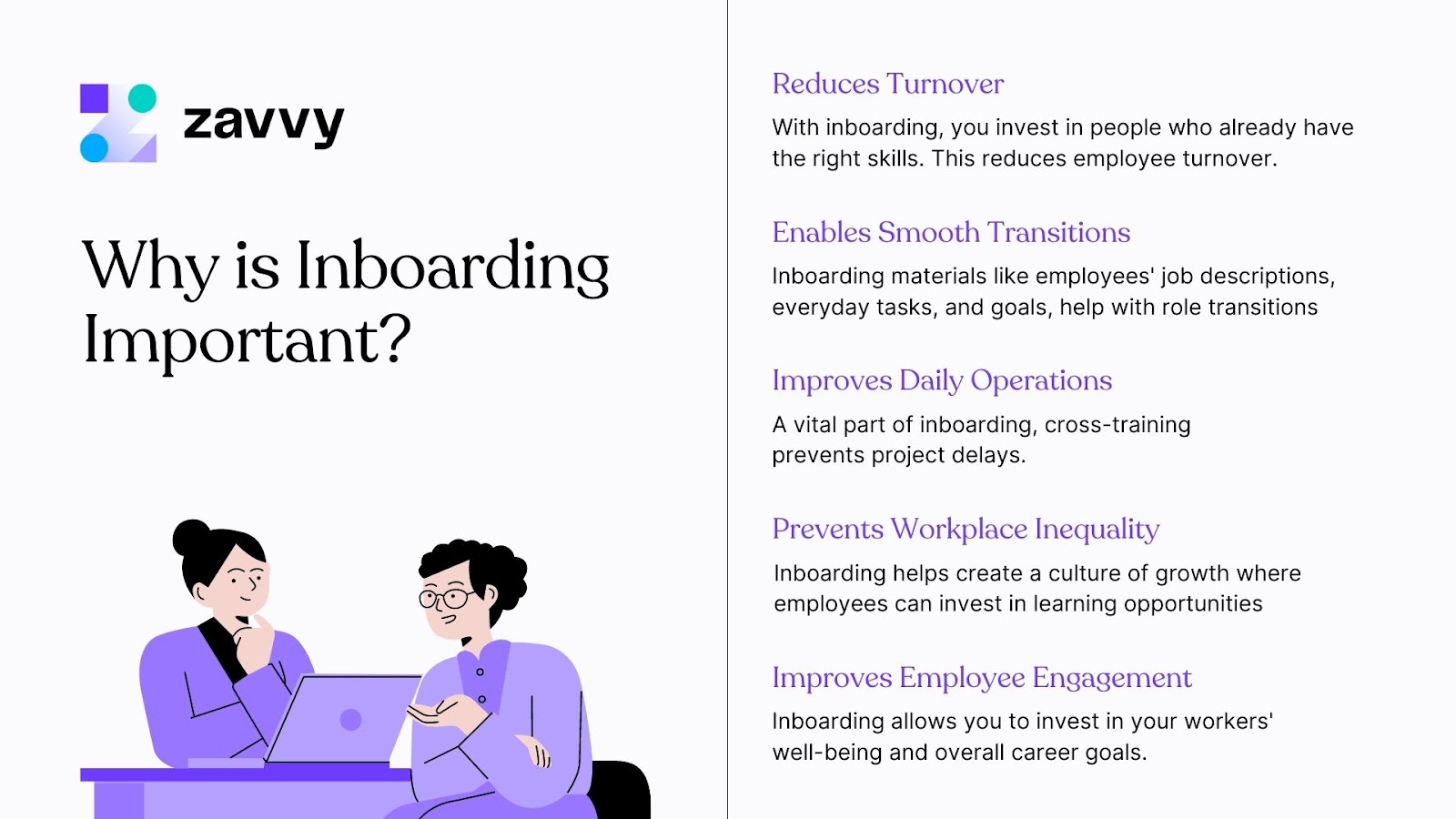
Inboarding affects every aspect of an organization. Employees who have worked for years need communication, training, and education as much as new hires. A Harvard Business Review study revealed that employees moving between units in a company rated the difficulty of transitioning at 70% as hard as joining a new company.
Need more motivation? Here are some compelling reasons why inboarding is essential:
In November 2021, roughly 4.5 million US workers voluntarily left their jobs. While many business leaders have their own conclusions, it all boils down to a single statement: Hiring the right people isn't enough—you need to retain and look after your existing workforce.
The cost of replacing an employee is about 100%-300% of the replaced employee's salary. Take that, and the fact that 3.6% of the workforce leaves their jobs every month. Shocking, right?
When you invest in inboarding, you invest in people who already have the necessary knowledge about your company, and to an extent, the role at hand. This helps reduce the costs of employee turnover and the time taken for new hires to adjust to their roles.
You won't see a loss in productivity, too, as the employees will already be upskilled and cross-trained to fill any immediate vacancies.
An inboarding plan helps employees looking to get promoted to a higher level or change divisions with a company transition smoothly. It includes inboarding materials such as employees' job descriptions, day-to-day tasks, goals for advancement, and processes for bringing employees to fill different positions.
This way, your organization will have a plan for anyone who gets promoted or changes departments.
Project work is another inboarding technique that helps with smooth transitioning. For example, an exceptional employee that has a chance to become a manager may not have enough financial knowledge for the role. Giving him a project will let him gain the required skills necessary to succeed there. Think of it as learning on the job.
When a team member is out of the office, either for personal reasons or on time off, the rest may struggle to fill in for them. This can hinder operations, leading to a loss in productivity. A vital part of inboarding, cross-training prevents this from happening.
Practical cross-training activities will educate coworkers on what their peers do, making it easier for them to step in and handle the latter's tasks when they are absent. This way, productivity is not lost, and companies are not dependent on just a handful of workers.
Employees often resent their peers who earn more, are frequently praised, or receive more opportunities. This leads to demotivation and conflict in the workplace.
Inboarding helps in preventing this type of toxicity. It helps create and nurture a culture of constant growth where employees are encouraged to invest in learning opportunities to advance in their careers. Through inboarding, managers can provide their team with a clear pathway to learning and evolving so all the employees have an equal chance to shine.
94% of employees say they will stay at a company longer if it invests in their learning and development. Luckily, inboarding allows you to invest in your workers' well-being and overall career goals. In addition, knowing that you care for them improves their morale and engagement.
Providing learning experiences for your employees can also help your company. If you invest in your staff, they will invest in you. Take companies like Apple, Google, and Netflix, for example. They readily invest in their staff, who show their appreciation for their efforts by being 40% more productive than the average employees.
Allowing your employees to learn, grow, and advance will make them more likely to put in their best work, thus increasing productivity.
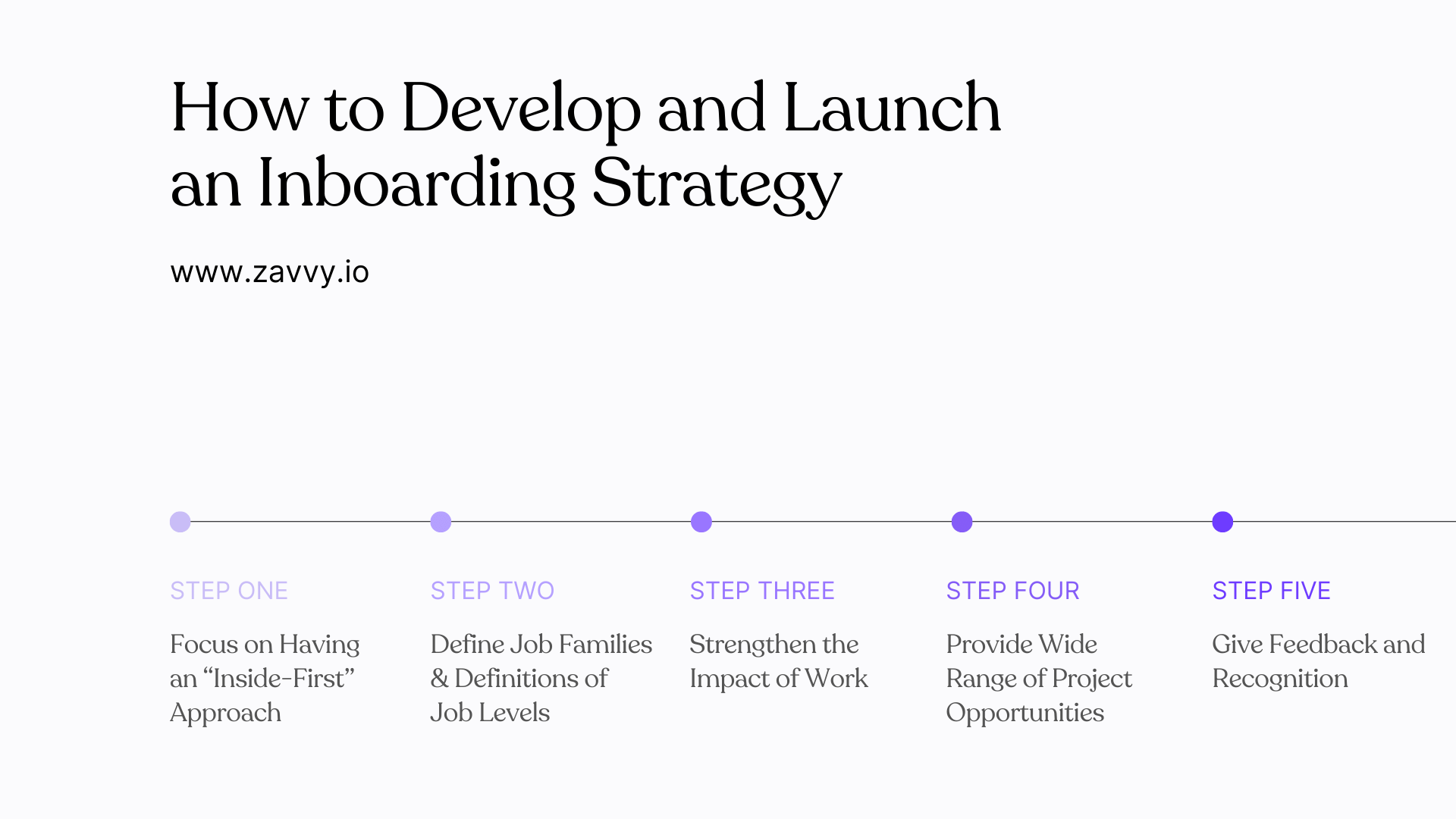
Creating an inboarding program involves careful thinking, planning, experimentation, and a strong feedback loop, similar to onboarding. When done correctly, it'll positively affect employee well-being and happiness, helping you retain top-performing talent for longer.
Below, we've outlined a step-by-step rundown of developing and launching a successful inboarding strategy for your organization.
If your first thought is to reach out to a recruitment agency—or look into your talent pool—to fill a vacancy within your company, stop. Consider your existing employees first. Do you have anyone with the potential to do the role?
Create a structured internal recruitment system that makes open positions available to your current team members, stimulating internal mobility. Employees can also mark themselves as 'open to opportunities.'
Not only will this help you save time spent scouting for talent and determining the right cultural fit but also motivate your existing workforce to take greater initiative in honing their existing skill sets.
The whole point of inboarding is to nurture talent to fill in vacancies, usually higher up the ladder. But for this to work, you need to understand your current company structure. Think: how many job levels do you have within a specific job role?
Establish clear competencies for each role and seniority so that your existing staff can understand where they are and what they need to do to improve. Be clear about the skills, knowledge, and expertise required for each job description.
Alternatively, you can use Zavvy's employee development software to set up career progression frameworks ("role cards ") from scratch—or simply use its ready-to-use templates for common job roles.
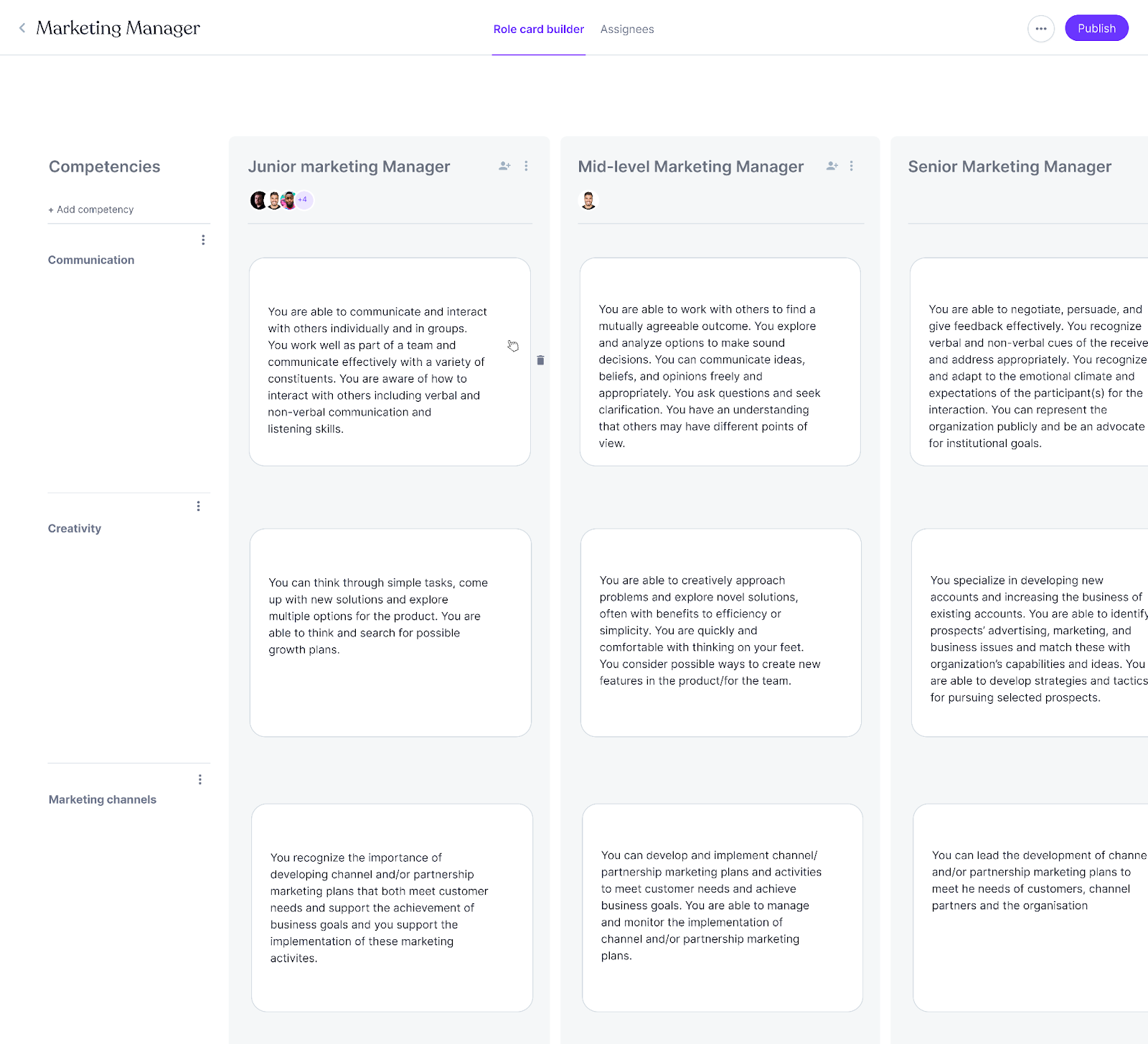
As you build your employee development plans, you can tailor these cards to your team's and company's unique requirements based on roles, job levels for each role, competencies, and competency descriptions. When you're finished setting up the development framework, you can connect all the dots—from peer review to competency models to sending guided reminders—from a central dashboard.
Learn how Freeletics used Zavvy to support its 40 people managers in their growth & development.
A critical aspect of successful inboarding is to have more motivated and engaged employees—and the best way to motivate them is to show them the impact of their efforts on the company and people. O.C. Tanner Institute sums up this sentiment beautifully here:
"Employees thrive when they feel part of something bigger than themselves, when they rise victorious over challenges and opportunities, and when they create meaningful relationships with coworkers.
They thrive when they can feel connected to a successful organization through their own achievements and great work. Organizations thrive when they have a culture that fosters this connection. They are more resilient and adaptable to the external forces that disrupt workplace culture."
Show them what their efforts have done, be it in terms of an increase in revenue or traffic or a testimonial from a delighted customer. Even better if you create a slideshow or give them some form of concrete proof to illustrate the before and after results of their contribution.
If you've got employees willing to improve their expertise, you need to provide them with career management tools that can help them advance their skill sets.
But before talking about job tools or training, we need to focus on the availability of job opportunities. For effective inboarding, you need to eliminate siloed departments and compartmentalized job descriptions. Give employees ample opportunity to take on more responsibilities based on their interests, allowing them to pick up new things, demonstrate initiative, and get more visibility.
While this is a solid start, employees may still need to upskill or feel uncertain about exploring new departments. That's where training comes into the picture.
A good inboarding program will always include training pathways for anyone who wants to get promoted or try out cross-department tasks. This can include certifications, doing live projects, shadowing mentors, or being a part of immersion days with other team members.
This will help employees discover new skills and attributes within themselves, ultimately benefiting your company.
Inboarding doesn't end when a team member gets promoted to a new role within the organization. You still have work left.
The employee will still need detailed feedback for doing their job efficiently and aligning their performance to company expectations. Schedule regular formal and informal performance evaluations to give feedback to let the employees know how they are doing in their new position.
At the same time, you also want to recognize their efforts for a job well done. Incorporate strong recognition pathways to provide visibility to accomplishments of all kinds that go beyond numerical goals. Appreciate employees whenever they take up new challenges, like guiding a new hire through the ropes or picking up a new skill.
Do this correctly, and you'll never have to worry about losing your top performers. You can also download our employee development plan template in Excel to get started with your employees' successful career growth.
After all the theory, let's have a look at a practical example from our own tool.
In this case, Maria has just been promoted to a people manager role.
As she'll be a first-time leader, there is a lot of new information Maria has to take in, and doing all that at once would just be overkill.
Instead, her promotion will automatically trigger an automated journey that will accompany her throughout the first year and beyond with just-in-time guidance.

At every important step of the way, Maria will receive relevant tips and training content.
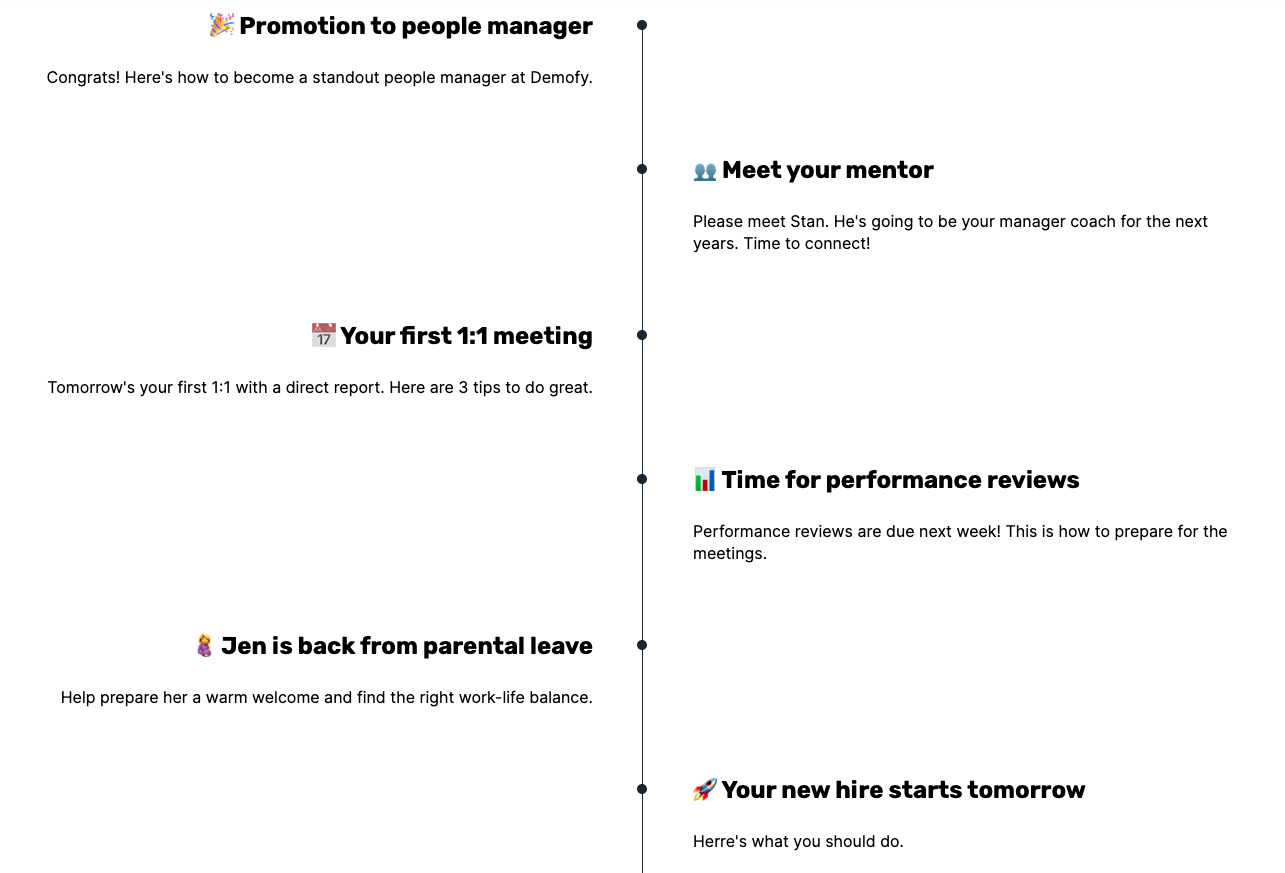
This workflow goes beyond traditional inboarding as it blends the worlds of learning and work in one more powerful stream.
On Zavvy, you can either run this workflow or build your own for cases like coming back from parental leave, being promoted from SDR or sales executive, and so on.
➡️ Curious? Get a more detailed breakdown of our just-in-time guidance workflows here!
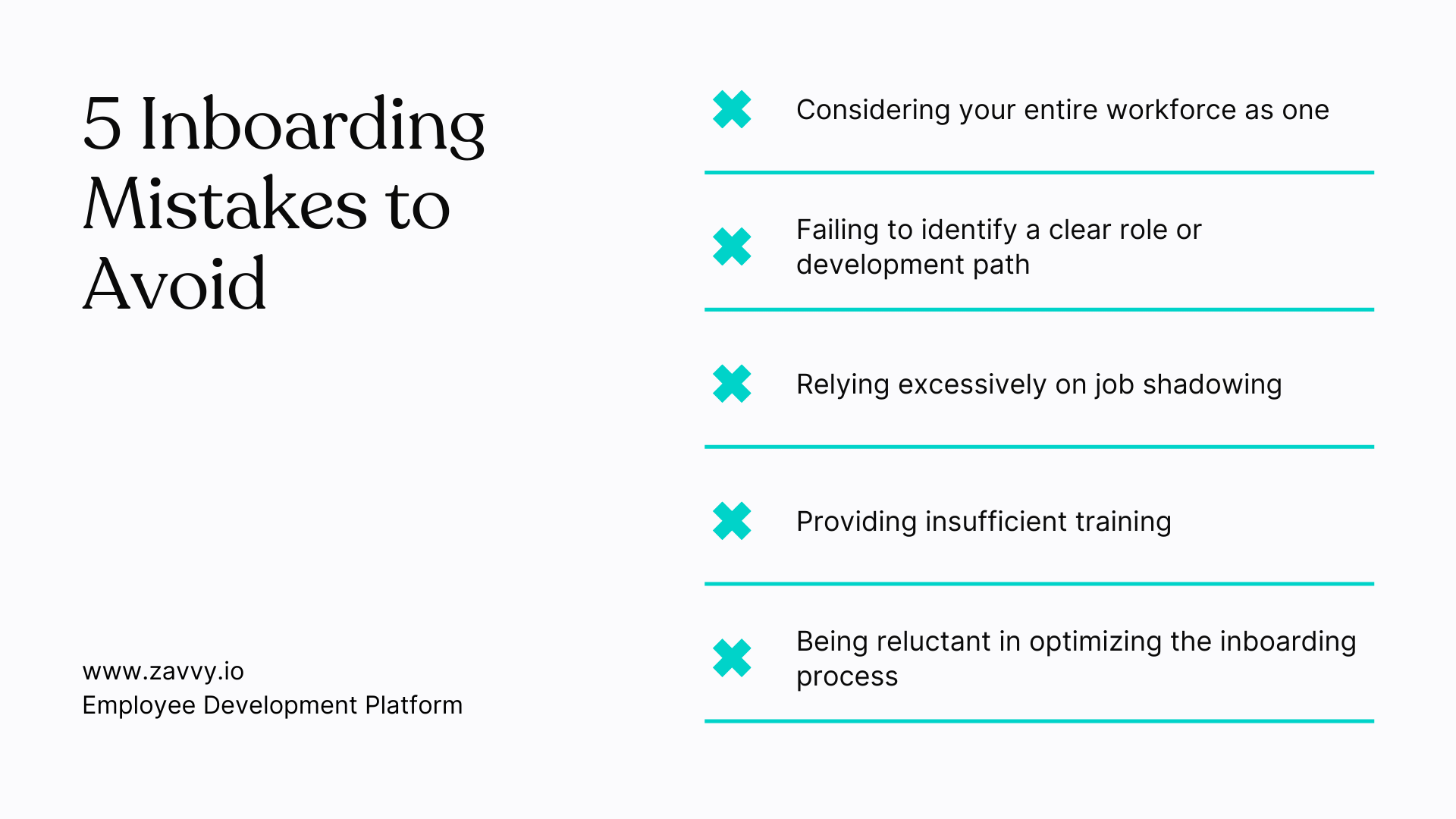
An established employee already knows the organization's culture and mission. So training them requires more thought and care than you would give to new hires.
The following are a few mistakes to avoid while inboarding:
Inboarding isn't just another terminology for career development—it's a dedicated and continuous commitment an organization makes to help their employees be at their personal best at their current job. It also gives them the experience and expertise they need for future opportunities.
Though all businesses are different, incorporating an excellent inboarding program can help most organizations with their retention rate and productivity. It's necessary to invest in inboarding before the employee turnover rate shoots up and current team members start to lose their engagement. Inboard regularly, and you'll be rewarded with a workforce dedicated to your company's success.
What's more, tools like Zavvy make onboarding seamless, effective, and hassle-free. Learn more ahout our development framework tool and see how it can help you set up powerful L&D processes to streamline inboarding.
Upskill your team every week with the best contents and personalized recommendations.

Companies everywhere have recognized the need for a good employee onboarding process. But they have overlooked a vital step: retaining these workers.
With 50% of employees leaving after the first two years of employment, there's a need to motivate workers to remain with the organization. The only catch? Hiring new talent and retaining them cannot be achieved with the initial onboarding alone.
You need to implement a second "onboarding process," known as inboarding. Let's see what it means and why it is an integral part of any HR process.
Get a demo!
We'll be happy to show you around and answer all your questions.
Trusted by innovative companies



We'll be happy to show you around, answer your questions, or arrange a free trial.
Erhalten Sie eine kostenlose Demo unserer Onboarding-Software.
Vertraut von



Your Training & Development Strategy - Solved in 1 Tool.
Trusted by innovative companies



We'll be happy to show you around, answer your questions, or arrange a free trial.
Learn how Zavvy helps you drive performance, development, and engagement.
Trusted by innovative companies



We'll be happy to show you around, answer your questions, or arrange a free trial.
We'll be happy to show you around and answer all your questions.
Trusted by innovative companies



We'll be happy to show you around, answer your questions, or arrange a free trial.
Gerne zeigen wir Ihnen ganz unverbindlich unsere Plattform im Detail.
Vertraut von modernen Unternehmen



Get a demo!
We'll be happy to show you around and answer all your questions.
Trusted by innovative companies



We'll be happy to show you around, answer your questions, or arrange a free trial.
Erhalten Sie eine kostenlose Demo unserer Software für Mitarbeiterenwicklung und Training.
Moderne Unternehmen
setzen auf Zavvy


